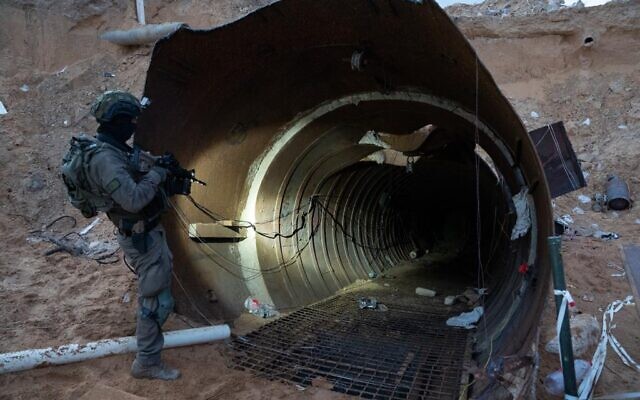The Israel Defense Forces on Sunday revealed the largest-ever Hamas attack tunnel discovered by the military, in the northern Gaza Strip, close to the Erez border crossing with Israel.
The tunnel, of which around four kilometers (2.5 miles) were uncovered by the IDF, goes down some 50 meters (165 feet) underground in some areas and appears to be wide enough for vehicles to pass through. It did not enter Israeli territory.
One of the shafts was found just 400 meters (a quarter mile) from the Erez Crossing, which until Hamas’s October 7 onslaught facilitated the movement of Palestinian civilians into Israel for work and medical care.
The IDF said that over the last few weeks, the Combat Engineering Corps’ elite Yahalom unit and the Gaza Division’s Northern Brigade used “advanced intelligence and technological means” to uncover the “strategic” tunnel network, scan it and clear it of any potential threats.
A map viewed by The Times of Israel showing the route of the tunnel has not been permitted for publication.
The Israel Defense Forces on Sunday revealed the largest-ever Hamas attack tunnel discovered by the military, in the northern Gaza Strip, close to the Erez border crossing with Israel.
The tunnel, of which around four kilometers (2.5 miles) were uncovered by the IDF, goes down some 50 meters (165 feet) underground in some areas and appears to be wide enough for vehicles to pass through. It did not enter Israeli territory.
One of the shafts was found just 400 meters (a quarter mile) from the Erez Crossing, which until Hamas’s October 7 onslaught facilitated the movement of Palestinian civilians into Israel for work and medical care.
A map viewed by The Times of Israel showing the route of the tunnel has not been permitted for publication.
The tunnel has several branches and junctions, along with plumbing, electricity and communication lines, according to the IDF. In some parts of the tunnel, troops found blast doors, which the IDF said were intended to prevent Israeli troops from entering.
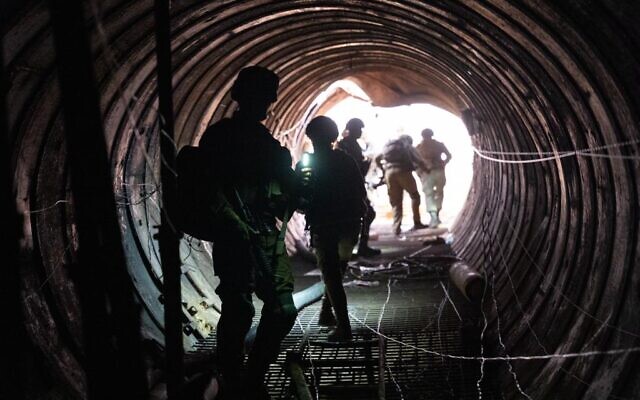
It said the tunnel allowed for the movement of vehicles, and “many weapons” belonging to Hamas were found inside.
“Its width indicates that it was intended to have been used for vehicle-borne raids against civilians in the Gaza border communities,” said the commander of the Gaza Division’s Northern Brigade, Col. Haim Cohen, in a video statement.
Cohen said none of the branches entered Israeli territory.
During the ongoing fighting in Gaza, Hamas has carried out several attacks against troops from the tunnel network, according to the IDF. It added that several days ago, several Hamas gunmen were killed inside the tunnel.
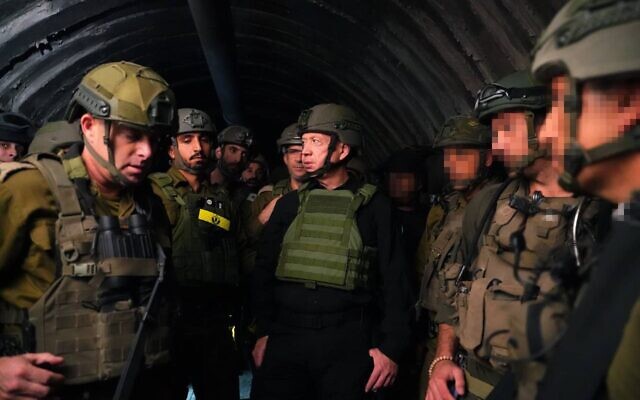
The IDF said that the ground offensive against Hamas in Gaza has provided “a lot of information about Hamas’s terror tunnels project.”
With the announcement, the IDF also published footage obtained from the Gaza Strip showing Hamas engineers constructing the tunnel. The footage showed members of the Palestinian terror group using specialized equipment to dig the tunnel.
According to the IDF, the construction of the tunnel involved a team of dozens of Hamas terrorists “who came especially for its construction from Khan Younis [in the southern Gaza Strip] to the north of the Gaza Strip.”
The Israel Defense Forces on Sunday revealed the largest-ever Hamas attack tunnel discovered by the military, in the northern Gaza Strip, close to the Erez border crossing with Israel.
The tunnel, of which around four kilometers (2.5 miles) were uncovered by the IDF, goes down some 50 meters (165 feet) underground in some areas and appears to be wide enough for vehicles to pass through. It did not enter Israeli territory.
One of the shafts was found just 400 meters (a quarter mile) from the Erez Crossing, which until Hamas’s October 7 onslaught facilitated the movement of Palestinian civilians into Israel for work and medical care.
The IDF said that over the last few weeks, the Combat Engineering Corps’ elite Yahalom unit and the Gaza Division’s Northern Brigade used “advanced intelligence and technological means” to uncover the “strategic” tunnel network, scan it and clear it of any potential threats.
A map viewed by The Times of Israel showing the route of the tunnel has not been permitted for publication.
The tunnel has several branches and junctions, along with plumbing, electricity and communication lines, according to the IDF. In some parts of the tunnel, troops found blast doors, which the IDF said were intended to prevent Israeli troops from entering.

It said the tunnel allowed for the movement of vehicles, and “many weapons” belonging to Hamas were found inside.
“Its width indicates that it was intended to have been used for vehicle-borne raids against civilians in the Gaza border communities,” said the commander of the Gaza Division’s Northern Brigade, Col. Haim Cohen, in a video statement.
During the ongoing fighting in Gaza, Hamas has carried out several attacks against troops from the tunnel network, according to the IDF. It added that several days ago, several Hamas gunmen were killed inside the tunnel.

The IDF said that the ground offensive against Hamas in Gaza has provided “a lot of information about Hamas’s terror tunnels project.”
With the announcement, the IDF also published footage obtained from the Gaza Strip showing Hamas engineers constructing the tunnel. The footage showed members of the Palestinian terror group using specialized equipment to dig the tunnel.
According to the IDF, the construction of the tunnel involved a team of dozens of Hamas terrorists “who came especially for its construction from Khan Younis [in the southern Gaza Strip] to the north of the Gaza Strip.”
It said the tunnel project was led by Muhammad Sinwar, the commander of Hamas’s southern brigade, and brother of Hamas’s Gaza leader Yahya Sinwar.
The IDF also released footage obtained from the Gaza Strip, showing Muhammad Sinwar in a car driving through the major tunnel.
The IDF said the materials used to build the tunnel “have not been seen so far in Hamas tactical tunnels.” It said the tunnel-boring machines used in the construction had been smuggled into the Strip.
According to military estimates, Hamas has invested millions of dollars in its tunnel network across the Gaza Strip.
“Since the beginning of the war, as well as during these days, the IDF has been working to locate and destroy dozens of attack tunnel routes, as part of the systematic dismantling of Hamas infrastructure,” it said.
In a press conference Sunday night, IDF Spokesman Rear Adm. Daniel Hagari said the tunnel was “no ordinary tunnel. It’s a city. A terrorist city underground that Hamas dug and built instead of investing money in the residents of Gaza.”
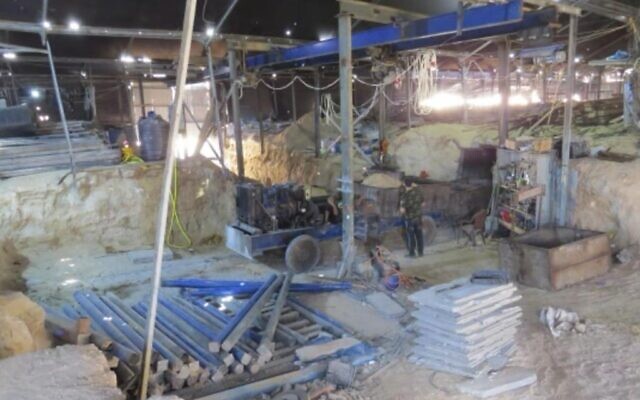
“We will continue to uncover the terrorist cities of Hamas underground, soon we will uncover more cities that we will take care of, we will kill terrorists [inside them] and destroy them,” he said, adding that the IDF is aware of at least three similarly sized tunnels in Gaza.
Last week, the IDF announced that soldiers had discovered more than 800 tunnel shafts in the Strip since the beginning of the ground offensive targeting Hamas that began in late October, some 500 of which had already been destroyed.
The IDF has also carried out a successful trial of pumping seawater into the vast network of tunnels beneath Gaza, a move aimed at destroying the Palestinian terror group’s subterranean network of passages and hideaways and at driving its operatives above ground.
Asked about concerns that the tactic might harm the hostages — some of whom are being held in Hamas tunnels — IDF Spokesman Rear Adm. Daniel Hagari said in a press conference Thursday that the army operates based on intelligence it has regarding where it believes the hostages are located and that it will not take steps that harm them.
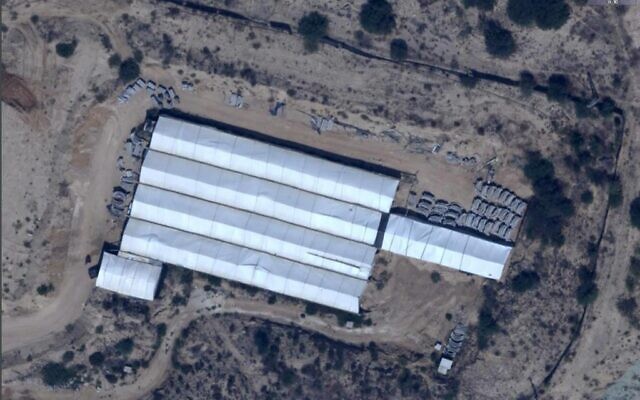
IDF forces have been battling Hamas on the ground in the Gaza Strip since late October. War erupted after the terror group’s October 7 massacre, which saw some 3,000 terrorists burst across the border into Israel from the Gaza Strip by land, air and sea, killing some 1,200 people and seizing over 240 hostages of all ages, mostly civilians.
In response, Israel vowed to eliminate Hamas, and launched a widescale offensive in Gaza. The Hamas-run health ministry in Gaza has claimed that more than 18,800 Palestinians have been killed since the start of the war. However, the number cannot be independently verified and is believed to include some 7,000 Hamas and Hamas-affiliated terror operatives as well as civilians killed by misfired Palestinian rockets.
It is believed that 128 hostages remain in Gaza, not all of them alive. During a week-long truce, Hamas released 105 hostages. Four hostages were released before the truce, and one was rescued by troops. The bodies of eight hostages have also been recovered and three hostages have been mistakenly killed by the military. The Israel Defense Forces has confirmed the deaths of 21 of those still held by Hamas, citing new intelligence and findings obtained by troops operating in Gaza.

